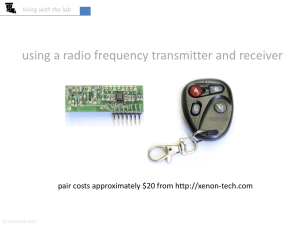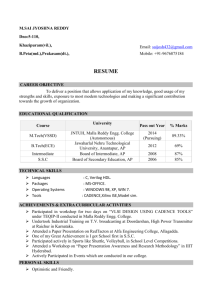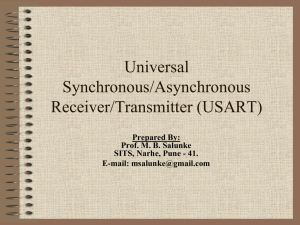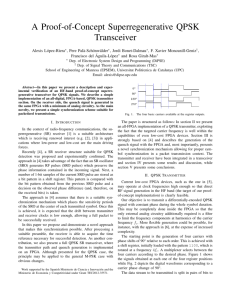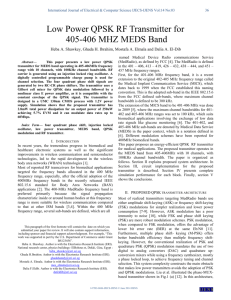Project Proposal Presentation.
advertisement
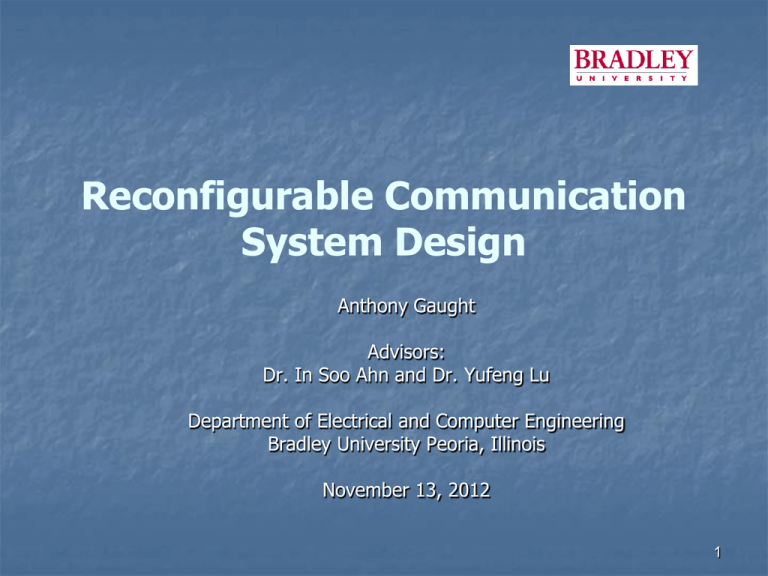
Reconfigurable Communication System Design Anthony Gaught Advisors: Dr. In Soo Ahn and Dr. Yufeng Lu Department of Electrical and Computer Engineering Bradley University Peoria, Illinois November 13, 2012 1 Outline Motivation Brief Theory of QPSK Project Overview Project Description Project Milestones Simulation Project Status Conclusions References 2 Motivation Software defined radio (SDR) has advantages over traditional communication systems. Design a reconfigurable digital communication system using FPGA. QPSK system is studied for the project. 3 Brief Theory of QPSK Binary phase shift keying (BPSK) is a modulation scheme which transmits one bit of data per symbol. Quadrature phase shift keying (QPSK) cuts the bandwidth necessary to transmit data in half when compared to BPSK. QPSK’s bit error performance is the same as that of BPSK due to orthogonality of the I and Q carriers used in QPSK. QPSK is used in many applications such as cell phones, satellite communication, cable modems, and others. 4 Brief Theory of QPSK s(t) = I(t)*cos(2πfot) – Q(t)*sin(2πfot) Each symbol represents two bits of data. I and Q bits are determined based on the phase of the received symbol. 5 Project Overview This project implements a QPSK communication system consisting of both a transmitter and a receiver. The system is designed using VHDL and is implemented on Xilinx Spartan 3E FPGAs. Allows for flexible transmission data rates. 6 Project Description at the transmitter Two-bit random data is generated. The data is split into In-phase (I) and quadrature-phase (Q) components. The data is shaped using raised cosine filters. The data is over sampled. The data is modulated by cosine and sine carriers. The modulated signals are combined for transmission. 7 Project Description at the receiver The received signal is demodulated by local cosine and sine carriers. The data passes through a matched filter. The data is down sampled. The data is fed into a threshold device. The output is displayed on an oscilloscope. 8 Milestone One The receiver and transmitter will be implemented on a single FPGA. The transmitter is connected directly to the receiver. A digital to analog converter (DAC) will be used to display data. 9 Milestone One Block Diagram I = transmitter side in-phase Q = transmitter side quadrature phase I_r = receiver side in-phase Q_r = receiver side quadrature phase S(n) = internal signal from transmitter to receiver 10 Milestone Two The receiver and transmitter will be implemented on different FPGA boards. Data will pass through an (ADC) and a DAC in this milestone. A carrier recovery circuit and phase locked loop will be implemented in the receiver. Adverse affects caused by channel imperfections will be explored. 11 Milestone Two & Three Block Diagram I = transmitter side in-phase Q = transmitter side quadrature phase I_r = receiver side in-phase Q_r = receiver side quadrature phase S(t) = signal from transmitter to receiver 12 Milestone Three High speed ADC and DAC modules will be used to connect the transmitter and receiver for assessing overall system operations. Bit error rate of the system will be used to evaluate the overall system performance. 13 Simulation Results I and Q data at the transmitter 14 Simulation Results The I and Q data are shaped using a set of raised cosine filters for controlling intersymbol interference. 80 60 40 20 0 -20 0 5 10 15 # of Filter coefficients 20 25 30 Impulse Response of Raised Cosine Filter 15 Simulation Results The recovered I and Q after being filtered are identical to theoretical results from MATLAB simulations. 16 Simulation Results The demodulated I and Q data match up with their theoretical results. 17 Simulation Results The demodulated I and Q data are then resized to bring the amplitude into a usable range for the Spartan 3E. 18 Simulation Results Received I and Q data appear as a constellation of 4 groups of points which matches the theoretical results well. 19 Simulation Results Transmitted and received I and Q data. 20 Simulation Results The transmitted and received I and Q data after being cleaned up by using a threshold device. 21 Project Status Milestone one has been completed. Preliminary work for Milestone two has begun. One of the biggest obstacles will be the implementation of the phase locked loop. 22 Schedule 1/24 - 2/07 phase locked loop and carrier recovery implementation 2/14 - 2/21 system optimization and evaluation 2/28 - 3/07 high speed ADC and DAC implementation 3/14 - 3/28 system evaluation 4/04 – 5/02 TBA note: the Bradley expo and project presentation will occur during this period. 23 Conclusions • • • FPGA design is flexible to build digital communication systems. The methods used for modulation can be reconfigurable. The system has a fast design turn-around time compared to conventional design using specialized hardware or DSP processors. SDR capabilities are to be investigated and demonstrated in the project. 24 References Anton Rodriguez, and Michael Mensinger Jr., “Software-defined Radio using Xilinx”, Senior Project Report, Department of Electrical and Computer Engineering, Bradley University, Peoria Illinois, May 2011. Anthony Gaught, “Software-defined Radio Symbol Generator”, Junior Project Report, Department of Electrical and Computer Engineering, Bradley University, Peoria Illinois, May 2012. Anthony Gaught, Alexander Norton, and Christopher Brady., “FPGA-based 16 QAM communication system”, EE 568 Report, Department of Electrical and Computer Engineering, Bradley University, Peoria Illinois, April 2012. Leon Couch, “Digital and analog communication systems”, 8th ed., Boston: Pearson, 2013. Charles Roth Jr., and Lizy John, “Digital systems design using VHDL”, 2nd ed., United States: Thomson, 2008. Spartan-3E Data Manual, Xilinx, San Jose, CA,2009. 25 Questions 26

